LABOUR WELFARE AND INDUSTRIAL RELATIONS
PAPER – III
Note : This paper contains seventy five (75) objective type questions of two (2) marks each. All questions are compulsory.
1. The Second National Commission on Labour suggested for an integrated adjudicatory system to deal with labour matters comprising of
(1) Labour Courts, Industrial Tribunals and Industrial Relations Commissions.
(2) Labour Courts, Lok Adalats and Labour Relations Commissions.
(3) Industrial Tribunals, Lok Adalats and Industrial Relations Commissions.
(4) Industrial Tribunals, National Tribunals and Labour Relations Commissions.
2. The interview which attempts to strip off the psychological defences of a candidate is called
(1) Depth Interview
(2) Structured Interview
(3) Stress Interview
(4) Comprehensive Interview
3. Under the Apprenticeship Act, 1961, every trade apprentice who has completed the period of training shall appear for a test, to determine his proficiency in the designated trade in which he has undergone training, to be conducted by
(1) The All Indian Council
(2) The National Council
(3) The Central Apprenticeship Council
(4) Directorate of Vocational Education
4. Which of the following is a quantitative job analysis technique ?
(1) Structured interview method.
(2) Observation method.
(3) Position analysis questionnaire.
(4) Participant diary/logs.
5. Which of the following statements relating to the Board of Conciliation is not correct ?
(1) The Board is a tripartite body.
(2) The Board is a permanent body.
(3) Conciliation proceedings before the Board are similar to those that take place before the Conciliation Officer.
(4) The board shall submit its report within two months of the date on which the dispute was referred to it.
6. What is ‘wild-cat’ strike ?
(1) Strike called by non-unionized workers, even if notice is given to the employer.
(2) Strike called by the union without giving any notice to the employer.
(3) Strike called by the union without resorting to ‘strike ballot’.
(4) Strike called by a group of workers at the spur of the moment without any formal notice to the employer and consent from the union.
7. Which one of the following is a supply forecasting method for calculating requirement of human resource ?
(1) Turnover analysis
(2) Work study technique
(3) Group Brainstorming
(4) Expert opinion
8. An organisation engaged in manufacturing jute has employed fifty employees. What is the amount of contribution the employer has to pay towards an employee drawing wages amounting to Rs.22,000 per month under the Employees’ Provident Fund and Misc.
Provisions Act, 1952 ?
(1) Rs.2,200
(2) Rs.2,640
(3) Rs.1,500
(4) Rs.1,800
9. Which of the following is true relating to the constitution of the child labour technical advisory committee under the Child Labour (Prohibition and Regulation) Act, 1986 ?
(1) It is constituted by the central government.
(2) It is constituted by the central government and state governments, for the Centre and State respectively.
(3) It is constituted by the State Governments only.
(4) It is constituted by the central government for each state in consultation with the respective state governments.
10. Which of the following National Trade Union Federations claims that, ‘it is not controlled by any political party, employers or government’ ?
(1) AITUC
(2) CITU
(3) UTUC
(4) NFITU
11. Assertion (A) : Decentralization removes the danger of “apoplexy at the top and anemia at the extremities”.
Reason (R) : The dispersal of authority, functions and responsibilities, brings relief to the overburdened central authority and strengthens field agencies and grassroots units.
(1) Both (A) and (R) are wrong.
(2) (A) is wrong and (R) is right.
(3) (A) is right and (R) explains the (A).
(4) (A) is right and (R) does not explain the (A).
12. Which of the following is false relating to the conditions prescribed for registration of building, workers as beneficiaries under the Building and Other Construction Workers (Regulation of Employment and conditions of Service) Act, 1996 ?
(1) A person employed to do any clerical or technical work for hire or reward in connection with building or other construction work.
(2) A building worker who has completed eighteen years of age, but has not completed sixty years of age.
(3) A building workers who has been engaged for not less than ninety days during the proceeding twelve months.
(4) A building worker who has been engaged for more than one hundred days in a calendar year.
13. Match List – A with List – B :
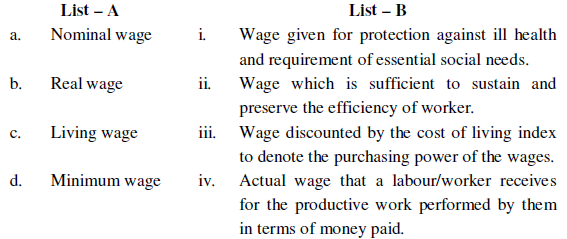
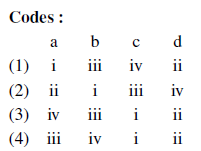
14. Which of the following statements relating to the amendment made in 2001 to the Trade Unions Act, 1926 is not correct ?
(1) The amendment requires the making of an application by at least 10 percent or 100 of the workmen (whichever is less) employed in an establishment or industry subject to the minimum of seven workmen, for registration as workers’ trade union.
(2) The amendment puts a limit on the proportion of outsiders to 1/3rd of the total number of office-bearers or 5, whichever is less generally, and 50 percent in the unorganised sector.
(3) The amendment says that the election of members of executive and office-bearers shall be held at an interval of not more than three years.
(4) According to the amendment an employee who has retired or has been retrenched shall be construed as an outsider for the purpose of holding an office in a trade union.
15. What is the time limit within which any claims arising out of payment of less than the minimum wages are to be made as per the Minimum Wages Act, 1948 ?
(1) Within six months from the date on which the minimum wages became payable.
(2) Within one year from the date on which the minimum wages became payable.
(3) Within four months from the date on which the minimum wages became payable.
(4) Within three months from the date on which the minimum wage become payable.
16. Which of the following HRM models take context as well as content factors of Business strategy linking with the HRM strategy ?
(1) Harvard model
(2) Warwick model
(3) David Guest model
(4) John M. Storey model
17. Which one of the following has recommended for the constituted of ‘Industrial Relations Commission’ on a permanent basis ?
(1) First National Commission on Labour
(2) Royal Commission on Labour
(3) Indian Labour Conference
(4) Standing Labour Committee
18. How many sets of principles does the Code of Discipline contain ?
(1) 2
(2) 3
(3) 4
(4) 5
19. What is the current amount of maximum gratuity payable under the Payment of Gratuity Act, 1972 ?
(1) Rs.10,00,000
(2) Rs.7,50,000
(3) Rs.12,00,000
(4) Rs.9,00,000
20. PAQ is related to Job analysis that focuses on employee activities. Which one is correct for PAQ ?
(1) Point Arc Questionnaire
(2) Position Analysis Questionnaire
(3) Performance Analysis Questionnaire
(4) People Analysis Questionnaire
21. As per the provisions of the Industrial Employment (Standing orders) Act, 1946, for which of the following organisations the central government is the appropriate government ?
(1) Major Ports
(2) Public Sectors Banks
(3) Minor Ports
(4) Air Transport Services
22. Assertion (A) : Labour is not a commodity.
Reason (R) : A seller of a commodity is least concerned with what happens to the commodity after he has sold it. But the labourer is very much concerned with the way the employer uses the labour and under what terms and conditions.
(1) (A) is right; but (R) is wrong.
(2) Both (A) and (R) are right; but (R) does not explain (A).
(3) (A) is wrong and (R) in trying to explain a wrong (A) is wrong.
(4) Both (A) and (R) are right; and (R) explains (A).
23. Who observed that “the person who influences me most is not he who does great deeds but he who makes me feel I can do great deeds” ?
(1) Peter F. Drucker
(2) Mary Parker Follett
(3) Chester I. Barnard
(4) Gordon Alport
24. What is generally the minimum number of days a woman employee actually should have worked in an establishment in order to be entitled for maternity benefit under the provisions of the Maternity Benefit Act, 1961 ?
(1) One hundred days
(2) Ninety days
(3) Eighty days
(4) Eighty four days
25. The Industrial Employment (Standing Orders) Act, 1946 has
(1) One schedule
(2) Two schedules
(3) Three schedules
(4) Four schedules
26. The effect-cause ratio on which problems are charted on Pareto Diagram is
(1) 60 : 40
(2) 65 : 35
(3) 70 : 30
(4) 80 : 20
27. The Constitution of India provides for distribution of legislative powers between central and state legislatures. This provision is contained in
(1) Fifth Schedule
(2) Seventh Schedule
(3) Fourth Schedule
(4) Sixth Schedule
28. Which of the following statements relating to the Model Grievance Procedure is/are correct ?
(a) The procedure specifies the complaints that come under its scope.
(b) The procedure gives the details of the constitution of Grievance Committee.
(c) It was drafted by a tripartite sub-committee appointed by the Indian Labour Conference.
(1) Only (a) is correct
(2) Only (b) is correct
(3) Only (c) is correct
(4) (a), (b) and (c) are correct
29. ‘Actio personalis moritur cum persona’ is the latin term for which of the following doctrines which employers used to follow to reject claims of compensation for employment injury ?
(1) Doctrine of contributory negligence.
(2) ‘The personal claim comes to an end with the death of either party’ doctrine.
(3) Doctrine of unknown person’s responsibility.
(4) Doctrine of assumed risk.
30. The Japanese word ‘Muda’ stands for which of the following themes ?
(1) Clean work place.
(2) Systematic arrangement of materials.
(3) Monotony at workplace.
(4) Any activity that absorbs resources but creates no value.
31. Which of the following was the first to recommend, for constituting a statutory tripartite organisation in India to deal with the labour matters ?
(1) Labour Investigation Committee
(2) First National Commission on Labour
(3) Royal Commission on Labour
(4) Second National Commission on Labour
32. Kanter and associates gave ten steps to implementing change. They are jumbled. Arranged them in the correct order :
(a) Create a sense of urgency
(b) Separate from the past
(c) Analyse the organisation and its need for change
(d) Support a strong leader role
(e) Develop enabling structures
(f) Line up political sponsorship
(g) Communicate and involve people
(h) Craft an implementation plan
(i) Create a shared vision and common direction
(j) Reinforce and institutionalise change
Codes :
(1) (c), (g), (b), (a), (d), (f), (h), (e), (i), (j)
(2) (b), (d), (c), (g), (a), (h), (f), (e), (i), (j)
(3) (c), (d), (a), (g), (h), (b), (e), (j), (i), (f)
(4) (c), (i), (b), (a), (d), (f), (h), (e), (g), (j)
33. Each labour legislation, which has been enacted is based on certain underlying principles. Match the legislation with underlying principle :
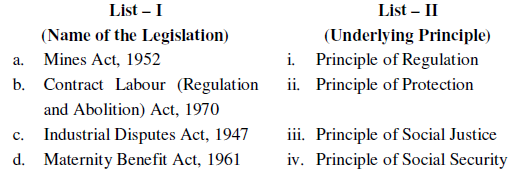
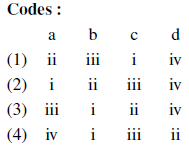
34. What is yellow dog contract ?
(1) A contract where a union agrees to inform the employer about the possible direct action of rival union.
(2) An unwritten contract with employer where a faction of the union acts as a whistle blower.
(3) When the management demands and secures an agreement from the workman that he would not join a union during the course of his employment; and if violates would be susceptible to lose the employment.
(4) The contract signed by every employee to join a management promoted union.
35. In explaining the dynamic of change who has given the formula “C = (ABD) > X” ?
(1) Noel Tichy and Maryanne Devanna.
(2) Richard Beckhard and Reuben Harris.
(3) David Nadler and Michael Tushman.
(4) Rosabeth Moss Kanter and Todd Jick.
36. ‘Volenti non fit injuria’ is the latin term for which of the following doctrines which employers used to follow to reject claims of compensation for employment injury ?
(1) Doctrine of Assumed Risk.
(2) Doctrine of contributory Negligence.
(3) Doctrine of common employment and fellow servants’ responsibility.
(4) Doctrine of unknown person’s responsibility.
37. Assertion (A) : Wage earners decided to organise themselves in order to counter the exploitation meted out to them by their respective employers.
Reason (R) : Workers developed common sentiments. They developed group interpretations and reactions to external environment, their social and economic situations and tried to organise themselves into associations that could meet the employers on an equal platform.
(1) (A) is correct but (R) is not correct.
(2) (A) is correct and (R) explains (A).
(3) (A) is correct but (R) does not explain (A).
(4) Both (A) and (R) are not correct.
38. Match the following contributors (List – I) with the concepts which they have propounded (List – II) :


39. The major objective of I.L.O. is creation of international standards of labour and in the process adopts conventions and recommendations. The conventions are to be ratified by the member country. If the convention is ratified by the member country, then the member country has to inform the same to I.L.O. The member country informs to the
(1) International Labour Conference.
(2) Governing Body.
(3) Chairman, Governing Body.
(4) Director General, International Labour Office.
40. Examine the following statements on selection and identify the ones which are true and false :
(a) Selection is a process of rejection.
(b) Predictor-criterion model is the foundation for setting out selection norms.
(c) Thematic Apperception Tests are not meant for cognitive measurement.
(d) Graphology is a scientific selection method.
(1) (a) and (b) are true, and (c) and (d) are false.
(2) (a), (b) and (c) are true; (d) is false.
(3) only (a) is true; (b), (c) and (d) are false.
(4) (b) and (c) are true; (a) and (d) are false.
41. The first National Commission on Labour recommended that works committee be set up in any unit which has
(1) 50 workers
(2) 100 workers
(3) more than 500 workers
(4) Recognised Union
42. Assertion (A) : Norms prescribed by Religious orders along with social customs used to play important role in regulating the behaviour and action of groups as well as individuals.
Reason (R) : Spread of knowledge of modern science and spirit of reasoning and scientific inquiry made the religious beliefs fail to stand the test and thereby paved way for enactment of legislations by state.
(1) (A) is correct but (R) explains (A).
(2) (A) is wrong and (R) is correct.
(3) Both (A) and (R) are correct but (R) does not explain (A).
(4) Both (A) and (R) are wrong.
43. Match the following :

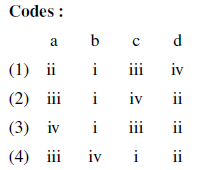
44. Match the terminologies of Disciplinary action (List – I) with their meaning (List – II) :

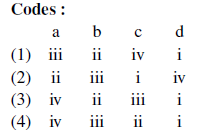
45. With regard to the provision of canteen under the Factories Act, 1948, for which of the following, the State Government may make rules ?
(a) The date by which such canteen shall be provided
(b) The standard in respect of construction of the canteen
(c) The price of foodstuffs to be served in the canteen
(d) The constitution of the managing committee for the canteen
(e) Number of employees to be engaged in running the canteen
(1) (a), (b), (c) and (d)
(2) (a), (b) and (d)
(3) (c), (d) and (e)
(4) (b), (c), (d) and (e)
46. Which of the following core conventions of ILO was ratified by India ?
(1) Convention No. 87 (Freedom of Association and Right to Organize)
(2) Convention No. 98 (Right to Collective Bargaining)
(3) Convention No. 105 (Abolition of Forced Labour)
(4) Convention No. 138 (Minimum Age Convention)
47. Performance Appraisal is an objective assessment of an individual’s performance against well defined benchmarks.
Performance Appraisal serves which of the following organisational objectives :
(a) Developmental
(b) Administrative/Decisions
(c) Organisational maintenance
(d) Documentation
Codes :
(1) (a), (b) and (c) only
(2) (b), (c) and (d) only
(3) (a), (b), (c) and (d)
(4) (a), (b) and (d) only
48. Which of the following is not true relating to the Rajiv Gandhi Shramik Kalyan Yojna (Unemployment Allowance) provided under the Employees’ State Insurance Scheme ?
(1) Unemployment allowance is paid equal to 50% of wages.
(2) Medical care for self and family from ESI Hospitals during the period the insured person receives unemployment allowance.
(3) Expenditure on fee and travelling allowance is to be borne by the Employees’ State Insurance Corporation for providing vocational training for upgrading skills.
(4) The daily rate of unemployment allowance is equal to the standard benefit rate, based on average daily wages during the last two contribution periods.
49. The Federal Mediation and Conciliation service in USA was created under the
(1) Landrum-Griffin Act
(2) Civil Service Reform Act
(3) Taft-Hartley Act
(4) Narris-Laguaradia Act
50. The penalty prescribed for committing unfair labour practices under the Industrial Disputes Act, 1947 is
(1) Imprisonment for a term which may extend to six months or with fine which may extend to one thousand rupees or with both.
(2) Imprisonment for a term which may extend to one year or with a fine which may extend to two thousand rupees or with both.
(3) Imprisonment for a term which may extend to six months or with fine which may extend to five thousand rupees or with both.
(4) Imprisonment for a term which may extend to one year or with fine which may extend to two thousand five hundred rupees or with both.
51. The source of conflict where cause for conflict exists in an incipient form, but it need not necessarily lead to actual conflict.
This may be described as :
(1) Behavioural view of conflict
(2) Conflict stimulation
(3) Antecedent conditions
(4) Inter-group conflict
52. Fatigue is a byproduct of various factors, either combined together or some of them or even any one of them. Some of the causative factors are mentioned below. Indicate, which among them are not the causative factors of fatigue :
(a) Muscular work
(b) Need of individual
(c) Length of work period
(d) Speed of work
(e) Repetitive nature of work
(f) Tension accompanying the task
Codes :
(1) (a) and (b)
(2) (c) and (d)
(3) (b) and (e)
(4) (e) and (f)
53. Assertion (A) : One of the core duties of a HR Manager is to get things done through people. To be effective be must balance his concern for people and work. He must know how to utilize human as well as non-human resources while translating goals into action.
Reason (R) : It must be recognised by the manager that individuals, not organisations, create excellence. Recognising the importance of the human element in the production process, Peter Drucker has remarked that “man, of all the resources available to man, can grow and develop”. The problem of establishing the right climate to maximise employee motivation and commitment is still with us.
Codes :
(1) (A) and (R) both are correct, (R) explains (A).
(2) (A) and (R) both are correct, (R) does not explain (A).
(3) (A) is correct, (R) is not correct.
(4) (A) and (R) both are not correct.
54. What is the full form of ACAS in the context of the industrial relations system in UK ?
(1) Arbitration Committee and Advisory Services.
(2) Advisory Committee and Arbitration Services.
(3) Advisory Conciliation and Arbitration Services.
(4) Arbitration Committee and Adjudication Services.
55. An establishment belonging to the manufacturing sector has employed fifty workers.
Identify, which of the following legislations shall be applicable to it :
(a) Industrial Disputes Act, 1947
(b) Industrial Employment (Standing Oders) Act, 1946
(c) Factories Act, 1948
(d) Payment of Wages Act, 1936
(e) Payment of Bonus Act, 1965
(1) (a), (b), (c) and (d) only
(2) (a), (b), (d) and (e) only
(3) (a), (b), (c) and (e) only
(4) (a), (c), (d) and (e) only
56. The trade union movement of which country is the oldest in the world ?
(1) Great Britain
(2) U.S.A.
(3) India
(4) Japan
57. Henry Mintzberg proposed three phases of decision making in organisations. Match the phases given in List – A, with the activities involved during these phases in List – B :
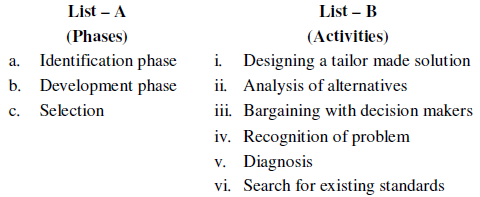
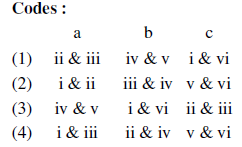
58. Calculate the amount of compensation that is to be paid to the dependants of an employee where death results from an injury under the provisions of the Employee’s Compensation Act, 1923. (Monthly wage of the employee was Rs.7,500 and the relevant factor is 207.98)
(1) Rs.1,20,000
(2) Rs.7,79,925
(3) Rs.9,35,910
(4) Rs.8,31,920
59. Which of the following statements is true relating the provision of first aid box under the Factories Act, 1948 ?
(1) One first aid box for every one hundred and fifty workers in a factory employing five hundred or more workers.
(2) One first aid box for every two hundred fifty workers.
(3) One first aid box for every one hundred and fifty workers employed at any one time.
(4) One first aid box for every one hundred workers employed at any one time.
60. Who was responsible for the establishment of the International Workingmen’s Association ?
(1) Sidney and Beatrice Webb
(2) George Potter
(3) Robert Owen
(4) Karl Marx
61. The American Federation of labour was formed in the year :
(1) 1806
(2) 1836
(3) 1886
(4) 1894
62. Life position comprises certain deeply ingrained convictions about worth of the self and others. The conviction about himself or herself may either be I’am OK or I’m not OK. Similarly he or she may look at others and think you’re OK or you’re not OK.
Match the life positions in Column – A with their nature in Column – B.

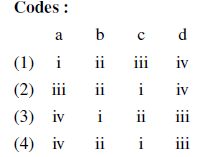
63. Who among the following is the ex-officio chairman of the Medical Benefit Council constituted under the Employees’ State Insurance Act, 1948 ?
(1) Director General, The E.S.I. Corporation
(2) Director General, Health Services
(3) Medical Commissioner of the Corporation
(4) Chairman, Medical Council of India
64. Match the following committees (List – I) with the area of coverage (List – II) :

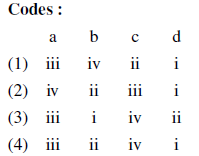
65. Which of the following principles of organisation is/are false ?
(a) Longer hierarchy in organisations create wider span of control.
(b) The authority, command and control in organisations flow in a descending order (c) As authority can be delegated and authority generates responsibility; responsibility also can be delegated.
(d) Functional foremanship advocated by Frederick Winslow Taylor is against the principle of unity of command.
(1) only (a) is wrong
(2) (a) and (c) are wrong
(3) (a), (c) and (d) are wrong
(4) (a) and (d) are wrong
66. Who have developed the Behavioural Theory of Labour Negotiations ?
(1) Richard Walton and Robert McKersie.
(2) Sidney and Beatrice Webb.
(3) N.W. Chamberlain and J.W. Kuhn.
(4) John Henry Richardson.
67. Which one of the following is true with regard to the Constitution of the Advisory Committee constituted under the Equal Remuneration Act, 1976 ?
(1) The committee consists of ten persons of which one-third shall be women.
(2) The committee consists of not less than ten persons of which one-half shall be women.
(3) The committee consists of twelve persons of which one-fourth shall be women.
(4) The committee consists of eight persons of which one-half shall be women.
68. What is the time limit within which the commissioner has to dispose of the matter relating to compensation from the date of reference under the Employee’s Compensation Act, 1923 ?
(1) Six months
(2) Three months
(3) One year
(4) Two months
69. There exists certain definite objetives behind State’s Regulation of Wages. Which among the following is not the objective of State Regulation of Wage :
(a) Prevention of sweating.
(b) Establishment of Industrial peace.
(c) Accelerating the pace of economic recovery.
(d) Trade Expenses.
(e) Social prestige.
(f) Preventing inflationary pressures and maintaining economic stability.
Codes :
(1) (a) and (b)
(2) (c) and (d)
(3) (e) and (f)
(4) (d) and (e)
70. Assertion (A) : The schemes of worker’s participation in management in India have proved ineffective in achieving the objectives for which they were set up.
Reason (R) : There is a basic conflict of interests between the owners of the enterprises and trade unions. While the managements are reluctant to part with their authority and prerogative to manage their enterprises, the trade unions are not prepared to part with their power manifested in collective bargaining.
Codes :
(1) (A) is right and (R) explains the (A).
(2) (A) is not right and (R) is right.
(3) Both (A) and (R) are wrong.
(4) (A) is wrong and (R) tries to explain the (A).
71. Match the following :
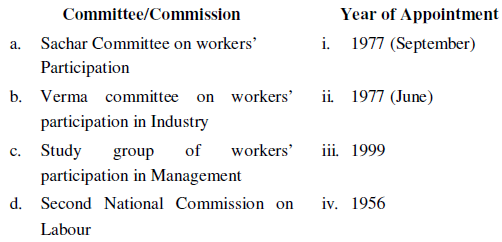
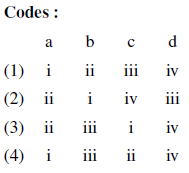
72. Which of the following provisions are covered under the Contract Labour (Regulation and Abolition) Act, 1970 ?
(a) Registration of principal employers
(b) Licensing of contractors
(c) Prohibition of employment of contract labour
(d) Regularisation of employment of contract labour
(1) (a), (b) and (c)
(2) (a), (b) and (d)
(3) (b), (c) and (d)
(4) (a), (c) and (d)
73. Which of the following is not a factor for calculation of compensation payable to an employee under the Employees’ Compensation Act, 1923 ?
(1) Monthly wage/salary of the employee.
(2) Years of service rendered by the employee.
(3) Age of the employee.
(4) Nature of injury sustained by the employee.
74. Hofstede (1991) distinguished four different layers of culture, ranging from more visible and superficial manifestations of culture to deeper and less tangible elements.
Match the Culture (List – A) with their descriptions given in List – B :
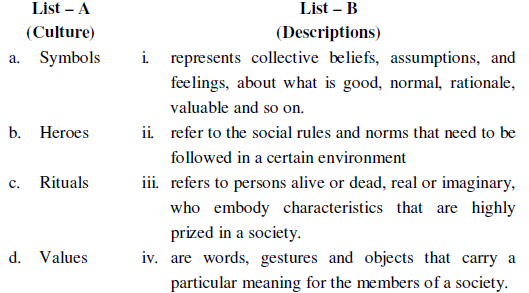
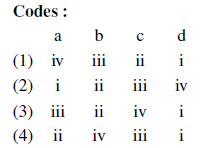
75. Which of the following statements are true/false with respect to Perlmutter’s (1969) work on top management’s attitude towards internationalisation and its impact on organisational structure, line of communication, information and approach to HRM activities etc ?
(a) Ethnocentric personnel management focuses to a great extent on recruiting and training parent country nationals for key positions, regardless of location.
(b) Polycentric personnel management is based largely on the view that values, norms, and customs differ from country to country and local markets can therefore best be reached by local managers (host country nationals)
(c) Geocentric approach is to utilize the best managers throughout the worlds, regardless of their nationality.
Codes :
(1) (a) is true, (b) and (c) are not true.
(2) (a) and (b) are true, (c) is not true.
(3) (a), (b) and (c) are true.
(4) (b) and (c) are true, (a) is not true.
Latest Govt Job & Exam Updates: